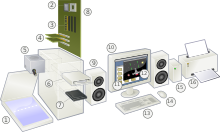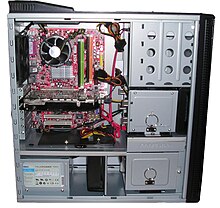Chapter 2: Hardware, Software, and Networking
7 Computer Hardware
From https://en.wikipedia.org/wiki/Computer_hardware
Computer hardware (or simply hardware in computing contexts) is the collection of physical elements that constitutes a computer system. Computer hardware is the physical parts or components of a computer, such as the monitor, keyboard, computer data storage, hard disk drive (HDD), graphic cards, sound cards, memory (RAM), motherboard, and so on, all of which are tangible physical objects.[1] By contrast, software is instructions that can be stored and run by hardware.
Software is any set of machine-readable instructions that directs a computer’s processor to perform specific operations. A combination of hardware and software forms a usable computing system.
Von Neumann architecture
The template for all modern computers is the Von Neumann architecture, detailed in a 1945 paper by Hungarian mathematician John von Neumann. This describes a design architecture for an electronic digital computer with subdivisions of a processing unit consisting of an arithmetic logic unit and processor registers, a control unit containing an instruction register and program counter, a memory to store both data and instructions, external mass storage, and input and output mechanisms.[3] The meaning of the term has evolved to mean a stored-program computer in which an instruction fetch and a data operation cannot occur at the same time because they share a commonbus. This is referred to as the Von Neumann bottleneck and often limits the performance of the system.
Different systems
There are a number of different types of computer system in use today.
Personal computer
Basic hardware components of a modern personal computer, including a monitor, a motherboard, a CPU, a RAM, two expansion cards, a power supply, an optical disc drive, a hard disk drive, a keyboard and a mouse.
The personal computer, also known as the PC, is one of the most common types of computer due to its versatility and relatively low price. Laptops are generally very similar, although they may use lower-power or reduced size components.
Case
The computer case is a plastic or metal enclosure that houses most of the components. Those found on desktop computers are usually small enough to fit under a desk; however, in recent years more compact designs have become more commonplace, such as the all-in-one style designs from Apple, namely the iMac. A case can be either big or small, but the form factor of motherboard for which it is designed matters more. Laptops are computers that usually come in a clamshell form factor; however, in more recent years, deviations from this form factor, such as laptops that have a detachable screen that become tablet computers in their own right, have started to emerge.
Power supply
A power supply unit (PSU) converts alternating current (AC) electric power to low-voltage DC power for the internal components of the computer. Laptops are capable of running from a built-in battery, normally for a period of hours.[6]
Motherboard
The motherboard is the main component of a computer. It is a large rectangular board with integrated circuitry that connects the other parts of the computer including the CPU, the RAM, the disk drives (CD, DVD,hard disk, or any others) as well as any peripherals connected via the ports or the expansion slots.
Components directly attached to or to part of the motherboard include:
- The CPU (Central Processing Unit), which performs most of the calculations which enable a computer to function, and is sometimes referred to as the brain of the computer. It is usually cooled by a heatsink and fan, or water-cooling system. Most newer CPUs include an on-die Graphics Processing Unit (GPU). The clock speed of CPUs governs how fast it executes instructions, and is measured in GHz; typical values lie between 1 GHz and 5 GHz. Many modern computers have the option to overclock the CPU which enhances performance at the expense of greater thermal output and thus a need for improved cooling.
- The chipset, which includes the north bridge, mediates communication between the CPU and the other components of the system, including main memory.
- Random-Access Memory (RAM), which stores the code and data that are being actively accessed by the CPU. RAM usually comes on DIMMs in the sizes 2GB, 4GB, and 8GB, but can be much larger.
- Read-Only Memory (ROM), which stores the BIOS that runs when the computer is powered on or otherwise begins execution, a process known as Bootstrapping, or “booting” or “booting up.” The BIOS(Basic Input Output System) includes boot firmware and power management firmware. Newer motherboards use Unified Extensible Firmware Interface (UEFI) instead of BIOS.
- Buses that connect the CPU to various internal components and to expand cards for graphics and sound.
- The CMOS battery, which powers the memory for date and time in the BIOS chip. This battery is generally a watch battery.
- The video card (also known as the graphics card), which processes computer graphics. More powerful graphics cards are better suited to handle strenuous tasks, such as playing intensive video games.
Expansion cards
An expansion card in computing is a printed circuit board that can be inserted into an expansion slot of a computer motherboard or backplane to add functionality to a computer system via the expansion bus. Expansions cards can be used to obtain or expand on features not offered by the motherboard.
Storage devices
Computer data storage, often called storage or memory, refers to computer components and recording media that retain digital data. Data storage is a core function and fundamental component of computers.
Fixed media
Data is stored by a computer using a variety of media. Hard disk drives are found in virtually all older computers, due to their high capacity and low cost, but solid-state drives are faster and more power efficient, although currently more expensive than hard drives, so are often found in more expensive computers. Some systems may use a disk array controller for greater performance or reliability.
Removable media
To transfer data between computers, a USB flash drive or optical discmay be used. Their usefulness depends on being readable by other systems; the majority of machines have an optical disk drive, and virtually all have a USB port.
Input and output peripherals
Input and output devices are typically housed externally to the main computer chassis. The following are either standard or very common to many computer systems.
Input
Input devices allow the user to enter information into the system, or control its operation. Most personal computers have a mouse and keyboard, but laptop systems typically use a touchpad instead of a mouse. Other input devices include webcams, microphones, joysticks, and image scanners.
Output device
Output devices display information in a human readable form. Such devices could include printers, speakers, monitors or a Braille embosser.




